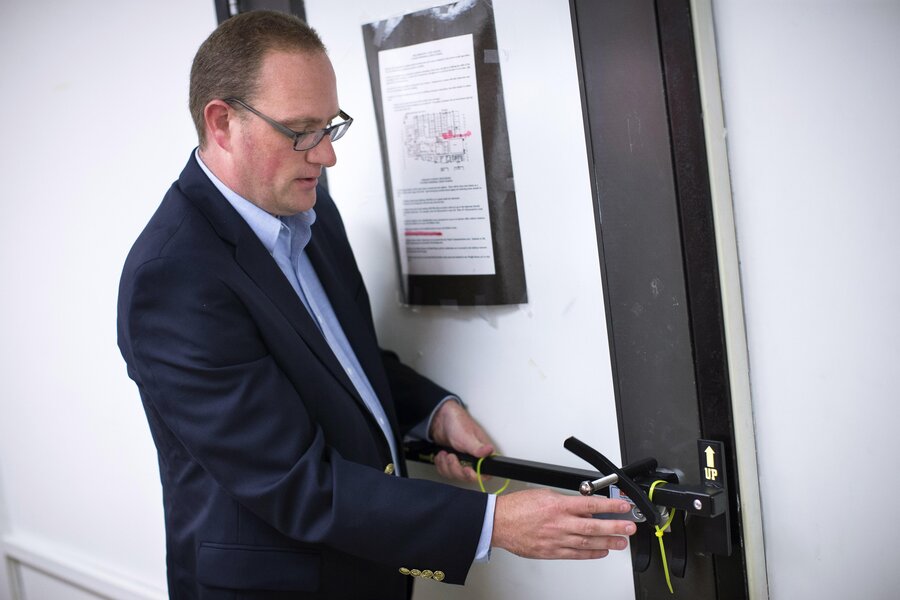Safety experts question classroom barricade devices
Loading...
| COLUMBUS, Ohio
A nationwide push allowing schools to buy portable barricade devices they can set up if an active shooter enters their building has school security and fire experts questioning whether they're really safe.
Those opposed to the devices say they're complicated to install under stress and could lead to dangerous unintended consequences — including blocking authorities from an attacker inside a classroom.
"Unlisted, unlabeled, and untested," said a July report by Ohio's building codes board critical of the devices. Nevertheless, the board was forced to update its codes to allow the devices after lawmakers approved them this summer following testimony from manufacturers and parents of school children.
The devices have gained popularity in the wake of the Virginia Tech and Sandy Hook massacres and a 2012 shooting in the Cleveland suburb of Chardon that killed three students. Some manufacturers post real-life 911 school emergency calls to their websites along with scary actor reenactments of intrusions.
Regardless of such sales tactics, many parents have legitimate concern about keeping their children safe in an era of mass shootings.
"I understand that these devices will not save all lives but for my son I want his teacher to have multiple layers of protection," said Erin West, whose 7-year-old son attends Southwest Licking schools in central Ohio, in testimony before lawmakers this spring.
Some devices slide under a door, while others attach to a door handle. Some require holes drilled into the floor for security pins.
But the National Association of State Fire Marshals says such devices could put people inside classrooms in peril — and run counter to recommendations made after the December 2012 Sandy Hook slayings. Critics say the devices could allow someone looking to do harm an easy way to cut victims off from help.
A better solution is doors that lock from the inside and can be opened from the outside with a key, said Jim Narva, the association's national director. The group cites research by the Sandy Hook commission that found no shooter has ever breached a locked classroom door.
ALICE, a national security training organization based in northeastern Ohio, recommends barricading classroom doors with desks and tables from the inside in case of an active shooter. The group won't endorse specific door devices out of concerns some may violate fire codes, better products may emerge in the future and schools may be over reliant on the device alone.
"This is analogous to buying fire extinguishers for your building but not training the building occupants how to respond during a fire," according to the organization.
Arkansas, Kansas, Michigan, New Jersey and Ohio are among states that have updated their fire or building codes in recent years to allow the devices, in some cases over the objection of state fire or building officials.
Schools today are dealing with "a different evil" that requires extra protection, said Daniel Hogan, co-founder of Conway, Arkansas-based Ulockit Security, which markets a device in several states, including Arkansas, Missouri and Oklahoma.
"We don't have to just stick with, 'Be scared and terrified, and not know what to do.' There are all kinds of options that we can do out there," Hogan said.
In Lake Stevens, Washington, the school district used a $44,000 state grant to buy 700 devices made by Michigan-based Nightlock, which secure a door by dropping a pin into a floor receptacle. In Sturgis, Michigan, the district bought about 250 Nightlock devices. Booneville schools in Arkansas bought about 150 ULockit devices and installed them for this school year.
Richard Harvey, the retired fire chief in Mentor, east of Cleveland, supported the local district's decision to buy barricade devices when he was in office. It makes more sense to have a barrier against violence than keep a passage unsecured on the off-chance of a fire, he told Ohio lawmakers in May.
Tom Mynsberge, a retired Michigan state trooper who runs Critical Incident Management, Inc., a security training company, said he believes the Nightlock device provides appropriate protection. But eventually he'd like to see all schools invest in solid doors and frames with bullet proof glass and one-motion locks on the inside.
"If you look at a lot of the shootings, a simple locked door would have prevented a lot of carnage," Mynsberge said.







